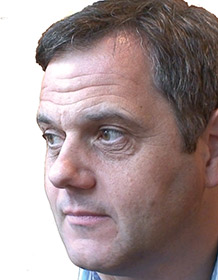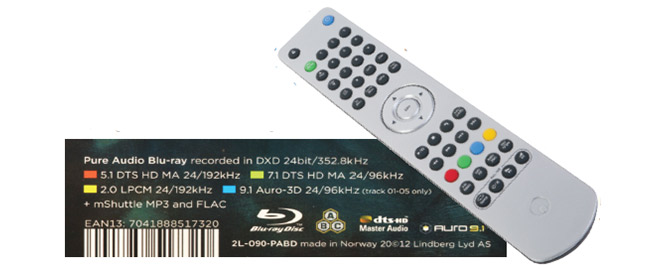Europe's online source of news, data & analysis for professionals involved in packaged media and new delivery technologies
The quest for sound perfection on Blu-ray

In a wide-ranging interview, STEFAN BOCK, Managing Director of msm-Studios and Pure Audio Blu-ray pioneer, shares his belief in a demand for high-resolution audio. He calls for a consumer-friendly standard and the need for a unified marketing approach as conditions for success.
When did you start?
We started in 1991 as a CD mastering facility and then expanded into audiovisual post-production, DVD then Blu-ray authoring. In short, everything related to disc. Our main focus is servicing customers in the music business, the major labels as well as the independents.
What is the breath of your music-related activities?
Pretty much everything related to media and post-production for music formats. It still means CDs, DVD and, of course, Blu-ray. Our key development, starting back in 2008, is Pure Audio Blu-ray. We released our first title the following year, produced by 2L in Norway.
Have you been involved with DVD-Audio and SACD?
Indeed, we have been dealing with both DVD-Audio and SACD. When we set up the studio in 1991 we had the capability to handle 20-bit formats, which was quite a significant change. But we always wanted to move to high resolution audio. We have been going through all the hassles of these different formats. So, we can boast an extensive experience.
With DVD-Video growing fast, why didn't DVD-Audio follow in the footsteps?
Several reasons. First, there was a format war with SACD. Second, DVD-Audio came too late, right after DVD-Video. Consumers had already bought their DVD player and would have had to buy another machine to play DVD-Audio, something which they refused to do. DVD-Audio disc can be authored in a way to play back on a standard DVD-Video player, but in this case only in reduced audio quality.
Manufacturers brought onto the market so-called universal players that could play out all the formats, but the industry did a bad job in educating the consumers on this new audio format. The market was confused and, whenever there is confusion, consumers hesitate to buy anything.
There are still SACD activities going on, but it's a very closed market. If you go out and ask people on the street what is SACD, most will have no clue.
How did your interest in working on Pure Audio Blu-ray come about?
Will history repeat itself? Will there be a Blu-ray Video, then a Blu-ray Audio format coming up later? What is the industry strategy? These questions were not answered for quite a long time. By 2008, it was clear that no particular audio format would be specified for Blu-ray. Keep in mind the Hollywood film industry was in the midst of a format war between HD DVD and Blu-ray. The music industry was not big enough to play a role in the Blu-ray audio scene.
Given that we already had a broad range of customers in the audio business, I thought it would be wise to come up with a solution for them. All of them knew how to handle high resolution audio, but there was no carrier available. I went back to my team with the question: Can we create something like an audio-only product for Blu-ray?
The Blu-ray specs already laid the ground for hi-def audio?
If you look into the Blu-ray specs, the audio ?format is extraordinarily good. The high-resolution playback capability is already built into the Blu-ray player. Every Blu-ray player is effectively a high resolution audio player. So, it was a no-brainer to seek to ?devise a solution to serve this market.
The only issue we had to deal with is that Blu-ray is in principle a video format. So, we had to somehow tell the BD player: "Look, this is a video, but please don't display the pictures to users!"
The whole project started with a small music label in Norway, 2L. They are famous for producing outstanding sound recordings and, for them, Pure Audio Blu-ray was the ideal format in which to release their titles. Given our ability to produce stereo versions along with multi-channel sound on the same disc, creating a Pure Audio Blu-ray disc was fairly straightforward.
2L is selling these titles very successfully. Today, we are working with 10-15 labels, and more than 70 titles have been produced, most of them available worldwide.
The Pure Audio Blu-ray discs include mp3 and FLAC digital files. How does it work?
When we had the first disc authored we presented it to a wide audience at the High-End show in Munich. Some important feedbacks we received were questions like: I have a Blu-ray player in my living room, I buy this Blu-ray disc, but how do I get to transfer the tracks onto my iPod, or burn them onto a CD to play in my car?
We quickly understood that, these days, you could not sell a physical product without giving the option of digital files. As the Blu-ray disc has enough storage capacity, we made digital files available on the disc itself. But we had to find a solution to access these files because, still today, most people do not have computers with a Blu-ray drive.
We developed a system called mShuttle that effectively turns the Blu-ray player into a web server. Via your computer you login to the IP address of your Blu-ray player and you access the tracks you can then copy from the Blu-ray disc to your computer. If you have already copied the mp3 files and, at a later stage, wish to copy the FLAC files, you just stick the disc into the player and copy them. All file types are available on a single carrier, that?s the mShuttle principle.
But most BD players are not connected to a home network. Is accessing these digital files enough of an incentive for users to wire their player to a network?
The incentive might be enough because you can access digital files without paying for them. As soon as you buy the disc you get digital files for free. A Pure Audio disc with mShuttle is therefore an extra value product. Surely, some Blu-ray players require a cable, while others are Wifi-capable. But more and more Blu-ray players are already Wifi-enabled. In any case, in the long term, it makes sense to connect your Blu-ray player to the Internet.
How much disc capacity is taken up by an average title with its digital files?
Most of the titles we make fit within a 25GB BD disc. Depending on the resolution and the audio format - stereo 24bit/192kHz, 5.1 and maybe 7.1 in 24bit/96kHz - the overall content might amount to 20GB.
We have a customer in Hong Kong who fills the entire disc with DSD files, so there is a user base for these files, and Pure Audio Blu-ray is simply a distribution carrier for DSD files.
Why don't you add video material as well on a 50GB Blu-ray Disc since there enough storage capacity to accommodate it?
We don't limit ourselves to audio only. There are some discs on the market already that have extra video content. We can apply the Pure Audio concept to any kind of concert or operas. But the majority of productions are audio-only. This is the solution for the records industry. Nobody would be able to afford the budget to produce a video along with the music recordings.
In terms of navigating through the various audio options and tracks on the disc, you have come up with a unique solution.
Because the Pure Audio Blu-ray disc is the successor to the CD, it was critical that the user experience be identical, namely, that navigation be controlled via the remote only, without the need to access a menu on TV. A straightforward screen-less navigation experience is key to the format's success.
Using BD-Java coding, we designed a system that uses the standardised colour keys on the remote controller of the Blu-ray player, each colour selecting an audio version. The remote's numerical keys select the respective tracks.

Some suggests that using BD-Java for Pure Audio Blu-ray disc is complicated and more expensive than HDMV. Is it true?
From a production standpoint, using Java coding might actually save a lot of time in manual authoring and quality-control. It enables streamlining the authoring, especially when it comes to high volumes.
Given that Pure Audio is still a niche, it is economically sustainable? Do you see consumers embracing the format?
It is a niche, yes, but it's a high quality product and if it is sold as such, I think it will find a wide audience of collectors and people that want the best quality available. There are already more than 100 million Blu-ray players in households worldwide, so the user base is potentially really big.
As with all new formats, high-end users are technology-savvy and the first adopters. Then it spreads to a wider audience. I do not think we will find this audience in a typical MediaMarkt chain in Germany. The big challenge today is to find new ways to market and sell high-definition audio titles.
What is the technological roadmap for Pure Audio? What applications are coming next?
We have to be careful adding extra features because the key principle is for the disc to offer a user-friendly experience. So, we have to keep it simple, staying away from complication. The content must remain easily accessible for everybody.
But of course we can add any feature we think can give the disc extra value. This could be something beyond mShuttle that takes advantage of the Cloud. Currently, you can already connect to the Internet via the disc's menu as well as access the files on the disc itself.
Second screen applications are something really interesting for Pure Audio Blu-ray as well. We already have a proof of concept that enables the operation of the disc with a smartphone. That's an elegant solution where the artwork of a title can be displayed on the smartphone together with the colour keys to control access to disc content, thus replacing the remote.
In the case of tablets, you could display extra information such as the visuals that originally featured on an LP sleeve. This would certainly add value to the Pure Audio Blu-ray disc. But again, production time will increase, production costs will increase, approval time will increase. In doing so, we will be moving away from the original idea of Pure Audio Blu-ray being a straightforward replacement of a CD.
Newcomers are entering the Pure Audio market like Universal Music, who launched its High Fidelity Pure Audio disc. How will you position yourself?
I am very happy that major companies like Universal are picking up on physical media as a high quality, high resolution format. This is really good. I see some problems, though, regarding the perception and expectation of end-users with the terminology 'Pure Audio.' Our Pure Audio Blu-ray concept has been introduced into the market years ago and consumers do have certain expectations of what Pure Audio means. We have to make sure they will not be disappointed. The biggest fear for me is that there will be some confusion in the market and people will look at this as another format war and stay away from the format.
We worked hard at designing a set of clear features that enable users to enjoy an optimal experience. Take the example of Pure Audio Blu-ray customers who already have a collection of discs and are therefore familiar with using numerical buttons on a remote to select tracks and colour buttons to select audio versions, without the need to turn the TV on. If they buy another Pure Audio disc that does not possess the same features they will be disappointed. And conversely. If the consumer's first Pure Audio title is a non-100% screen-less disc, he might be disappointed from the start and wont buy into the format, thus missing on Pure Audio disc with 100% functionality.
Is there a meeting of minds emerging?
We ought to unify and make a clear statement to users. For all of us, the main goal is to offer the best experience possible to end-users. We already have a worldwide network of studios in place, that we have enabled to offer Pure Audio authoring. And the network is expanding. We have had constructive meetings with Universal towards finding a common solution to guarantee a consistent consumer experience. Unfortunately, we have not come to a final agreement yet.
Contact: www.pureaudio-bluray.come.
...
On predicting the future

Predicting the future, let alone the future of packaged media, is a perilous exercise, and possibly counter-productive, as the exercise closes doors rather than keep them open, argues JEAN-LUC RENAUD, DVD Intelligence publisher. Consider that: Apple was left nearly for dead 15 years ago. Today, it became the world's most valuable technology company, topping Microsoft.
Le cinéma est une invention sans avenir (the cinema is an invention without any future) famously claimed the Lumière Brothers some 120 years ago. Well. The cinématographe grew into a big business, even bigger in times of economic crisis when people have little money to spend on any other business.
The advent of radio, then television, was to kill the cinema. With a plethora of digital TV channels, a huge DVD market, a wealth of online delivery options, a massive counterfeit underworld and illegal downloading on a large scale, cinema box office last year broke records!
The telephone was said to have no future when it came about. Today, 5 billion handsets are in use worldwide. People prioritize mobile phones over drinking water in many Third World countries.
No-one predicted the arrival of the iPod only one year before it broke loose in an unsuspecting market. Even fewer predicted it was going to revolutionise the economics of music distribution. Likewise, no-one saw the iPhone coming and even fewer forecast the birth of the developers' industry it ignited. And it changed the concept of mobile phone.
Make no mistake, the iPad will have a profound impact on the publishing world. It will bring new players, and smaller, perhaps more creative content creators.
And who predicted the revival of vinyl?
(click to continue)... Read More...



















